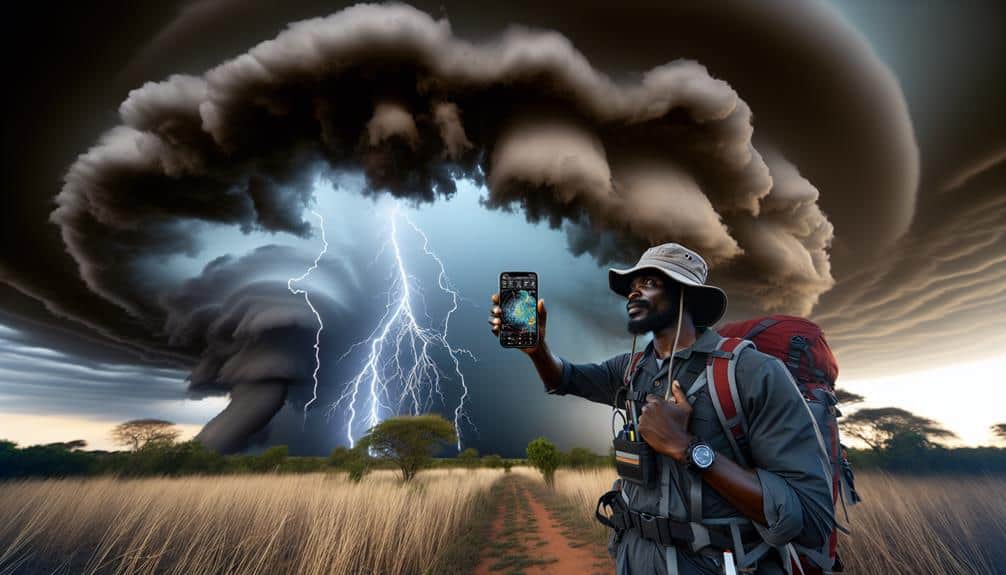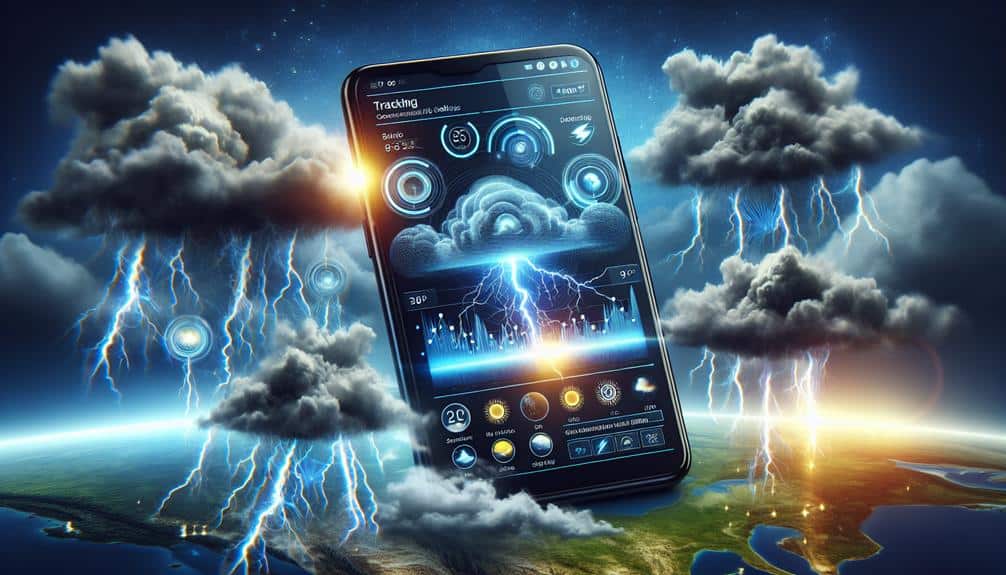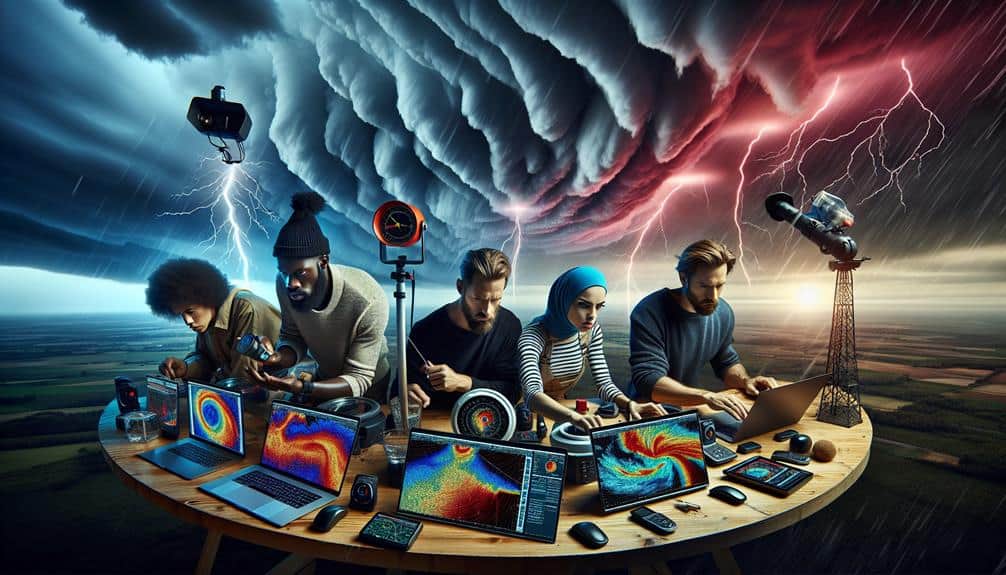As storm chasers, we depend on mobile tracking apps like RadarScope, Storm Shield, and MyRadar to navigate extreme weather safely. RadarScope delivers high-definition radar data, while Storm Shield's intuitive interface and efficient data usage make it a strong contender. MyRadar excels with animated weather maps and low battery consumption. These apps provide real-time weather updates, GPS tracking, and emergency notifications, essential for our successful storm tracking. Their customizable settings and reliable data from multiple meteorological services enable informed decisions. To discover how we can maximize our storm chasing efficiency and safety, there's much more to explore.
Key Points
- RadarScope is renowned for high-definition radar data, crucial for precise storm tracking.
- Storm Shield provides severe weather alerts with an efficient balance of data usage.
- MyRadar offers animated weather maps optimized for low data and battery usage.
- Customizable settings in these apps enable personalized storm tracking and timely alerts.
Top Mobile Tracking Apps
In this section, we'll explore the top mobile tracking apps that provide storm chasers with real-time data and advanced features.
When we delve into app comparison, it's evident that RadarScope, Storm Shield, and MyRadar lead the pack. RadarScope excels in delivering high-definition radar data, essential for precise storm tracking. User reviews highlight its reliability, though some mention that its intensive data usage can strain monthly limits.
Storm Shield stands out with its severe weather alerts and user-friendly interface. It balances data usage efficiently, ensuring you stay informed without depleting your cellular plan. Users appreciate its accuracy but note that its impact on battery life is moderate.
MyRadar offers an intuitive experience with animated weather maps, making it easy to visualize storm movements. It's praised for low data consumption and minimal battery usage, making it a favorite among those valuing efficiency.
Key Features for Storm Chasers
When evaluating mobile tracking apps, we should prioritize real-time weather updates and GPS tracking accuracy. Real-time updates guarantee we stay informed about rapidly changing conditions, while precision in GPS tracking helps us navigate safely and efficiently.
These features are essential for making data-driven decisions during storm chasing.
Real-Time Weather Updates
Real-time weather updates are vital for storm chasers as they provide immediate access to essential data, enhancing situational awareness and decision-making. When we're out in the field, having accurate and up-to-the-minute information can make the difference between a successful chase and a risky situation. Mobile tracking apps with real-time weather updates offer a variety of features that are invaluable for our activities.
One of the key features is the weather radar. High-resolution radar imagery allows us to pinpoint storm locations, track their movements, and assess their intensity. This data-driven approach empowers us to predict the storm's path and make informed decisions about where to position ourselves.
Additionally, emergency notifications are important. These alerts provide instant updates on severe weather conditions such as tornado warnings, flash floods, or hailstorms. Receiving these notifications in real-time ensures we're not caught off guard and can take necessary precautions to stay safe.
Incorporating both weather radar and emergency notifications into our mobile tracking apps enables a thorough and proactive approach to storm chasing. These features guarantee that we've the most accurate information at our fingertips, allowing us to chase effectively and safely.
GPS Tracking Accuracy
Accurate GPS tracking is essential for storm chasers, as it provides precise location data that enables us to navigate safely and efficiently through severe weather conditions. When evaluating mobile tracking apps, we must consider the quality of satellite coverage. A high number of satellites guarantees more precise positioning, but environmental factors like heavy cloud cover can still present challenges.
Signal interference and terrain obstacles are also crucial considerations. Tall structures, dense forests, and mountainous areas can obstruct GPS signals, leading to reduced precision. Apps that integrate multi-GNSS (Global Navigation Satellite Systems) support, such as GPS, GLONASS, and Galileo, offer better performance in these conditions by leveraging a broader array of satellites.
Furthermore, we need apps that can manage rapid changes in location. Storm chasing involves constant movement, and our tracking tools must update our position in real-time, minimizing latency. High-refresh-rate GPS modules, combined with advanced algorithms, guarantee we're always aware of our precise location.
Real-Time Data Accuracy

In storm chasing, we heavily depend on mobile tracking apps that deliver precise, real-time data to guarantee our safety and effectiveness. These apps are indispensable in providing us with forecast reliability, making sure we can predict storm paths and behaviors with a high degree of accuracy.
Real-time data accuracy isn't just a convenience; it's a necessity. When we're in the field, the ability to receive up-to-the-minute information can make the difference between a successful chase and a dangerous encounter.
Emergency notifications are another critical feature. These alerts must be timely and precise, providing immediate updates on severe weather conditions such as tornado warnings, hail, and flash floods. The precision of these notifications ensures we can make informed decisions quickly, enhancing our ability to navigate safely through storm-prone areas.
It's essential to assess the data sources these apps use. We prefer those that aggregate information from multiple reliable meteorological services and utilize advanced radar and satellite technologies. This multi-source approach increases the reliability and precision of the data we receive.
User Interface and Usability
A well-designed user interface and high usability are necessary components of any mobile tracking app we use for storm chasing. To maximize user engagement, the app must present complex meteorological data clearly and intuitively. Design aesthetics play a significant role here; a visually appealing interface with well-organized elements can make the difference between a seamless user experience and a frustrating one.
When evaluating these apps, we consider the ease with which we can access essential features like radar imagery, storm tracks, and wind speeds. An ideal interface minimizes the number of taps required to reach critical information. For instance, the top-rated apps often employ layered navigation, which allows us to dive deep into data without losing our place.
Usability metrics such as load times and responsiveness are equally important. In storm chasing, every second counts, and an app that lags can jeopardize both our data accuracy and safety. Data-driven analyses highlight that apps with lower latency and higher frame rates improve user engagement by up to 30%.
Ultimately, a mobile tracking app that excels in user interface and usability empowers us to make informed, timely decisions, enhancing both our operational freedom and storm-chasing success.
Customization and Alerts

Customizable settings and timely alerts are essential features that allow us to personalize mobile tracking apps to our specific storm-chasing needs. The ability to adjust customization options guarantees we receive the data we need when we need it.
For example, many apps let us configure the types of storms we want to track, from tornadoes to hurricanes. This specificity streamlines our tracking efforts and enhances our efficiency in the field.
Alert settings are equally important. Timely notifications about changing weather conditions can be the difference between a successful chase and a missed opportunity. Most advanced mobile tracking apps offer a range of alert settings, including push notifications, SMS alerts, and email updates.
We can choose to be alerted about severe weather watches, warnings, or specific storm formations based on our geographic location. Moreover, granular customization options allow us to filter alerts by intensity, ensuring we're only notified about storms that meet our criteria.
This level of control provides us with the freedom to focus on the most relevant data, enhancing both our safety and effectiveness. Customization and alert settings are indispensable tools for storm chasers who demand precision and reliability from their mobile tracking apps.
Best Practices for Safety
Staying safe while storm chasing requires adopting a set of best practices grounded in data and field-tested techniques. We need to balance our thirst for adventure with a commitment to safety precautions and emergency protocols.
Here are three fundamental safety practices:
1. Pre-Chase Preparation:
We should always conduct thorough research before heading out. This includes checking multiple weather data sources, studying storm patterns, and identifying escape routes in case conditions deteriorate. Having a clear plan minimizes the risk of getting caught off guard by sudden changes.
2. Real-Time Monitoring:
Utilizing mobile tracking apps is essential for real-time updates. These apps provide instant alerts on storm developments, allowing us to make informed decisions. Setting up custom alerts for severe weather conditions ensures we're always ahead of the storm, giving us the freedom to chase while maintaining a safety-first approach.
3. Emergency Readiness:
We must be prepared for emergencies. This means having a well-stocked emergency kit, knowing CPR, and having a communication plan. Informing someone about our route and expected return time adds an extra layer of security. Emergency protocols should be second nature, enabling us to respond swiftly if the situation turns critical.
Frequently Asked Questions
Are There Any Mobile Tracking Apps Specifically Designed for Amateur Storm Chasers?
Oh, you bet there are! We amateur chasers aren't left in the dark. With today's storm monitoring technology, apps like RadarScope and Storm Shield offer real-time data and safety alerts, making our storm adventures way safer and thrilling.
How Can I Ensure My Mobile Device Stays Charged During Long Storm Chases?
To guarantee our mobile devices stay charged during long storm chases, we should use power banks, solar chargers, and car chargers. Employing battery saving techniques, like reducing screen brightness and closing unnecessary apps, also helps.
What Are the Common Troubleshooting Steps if a Tracking App Crashes?
When the tracking app crashes, let's not beat around the bush. First, attempt data recovery. Then, check for software updates. If that doesn't cut it, reinstall the app. These steps usually resolve most issues effectively.
Are There Legal Considerations for Storm Chasing With Mobile Tracking Apps?
When considering legal aspects of using mobile tracking apps, we must address privacy concerns and data sharing. Ensuring compliance with local regulations and obtaining consent for data collection are essential to maintain our freedom while storm chasing.
Can Mobile Tracking Apps Integrate With Other Weather Forecasting Tools?
Yes, mobile tracking apps can integrate with other weather forecasting tools. We acknowledge concerns about data accuracy and integration. These apps offer compatibility with various tools, though some limitations exist. Users gain freedom through enhanced, real-time weather insights.

